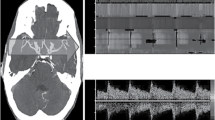Abstract
The validity of transcranial doppler (TCD) as a monitor of cerebral blood flow during hypothermic selective cerebral perfusion (SCP) was investigated in dogs. Cerebral flow was maintained by infusing blood into the aortic arch while the descending aorta was totally crossclamped. The anterior cerebral arterial blood flow velocity (ACAv) was continuously measured with the EME TC2-64 TCD velocimeter by transorbital approach. In five dogs, cerebral flows were varied in steps from 5 to 10, 15, and 20 ml/kg/min in both cooling phase (rectal temp.: 25°C, 20°C) and rewarming phase (25°C, 30°C). ACAv was 46 ± 7 cm/sec before cardiopulmonary bypass (CPB) started. Correlations between cerebral perfusion flow rate and ACAv were 0.59 in cooling phase and 0.85 in rewarming phase. In eight beagles, after core cooling at a constant systemic perfusion flow rate of 80 ml/kg/min, SCP was performed for 90 min at 25°C; Group I (n = 4): 5 ml/kg/min, Group II (n=4): 10 ml/kg/min, and rewarmed. Carotid arterial pressure (CAP) and ACAv were monitored continuously. Furthermore changes of jugular venous blood lactate/pyruvate concentration ratio after SCP were compared between groups. Percent changes of CAP during SCP for pre-CPB value were not significant between groups. Percent change of ACAv during SCP was significantly higher in Group II (59 ± 12%) than in Group I (34 ± 8%). Ninety minutes after SCP, lactate/pyruvate concentration ratio was increased in Group I (125 ± 44%) and decreased in Group II (73 ± 18%) for pre-CPB value. In Group I, it was considered that anaerobic metabolism and glycolysis were progressed. These results suggest that changes in ACAv reliably correlate with changes in cerebral perfusion flow rate and reflect cerebral metabolism. In five clinical cases, ACAv during SCP were about 50% of preoperative values. All the patients awoke well after operations and had no neurological complications. In conclusion, ACAv measured with TCD is available in monitoring cerebral blood flow during hypothermic SCP.
Similar content being viewed by others
References
Aaslid R, Markwalder TM, Nornes H: Noninvasive transcranial doppler ultrasound recording of flow velocity in basal cerebral arteries. J Neurosurg 57: 769–774, 1982
Huber P, Handa J: Effect of contrast material, hypercapnia, hyperventilation, hypertonic glucose and papaverine on the diameter of the cerebral arteries. Angiographic determination in man. Invest Radiol 2: 17–32, 1967
Hansen NB, Stonestreet BS, Rosenkrantz TS, Oh W: Validity of doppler measurements of anterior cerebral artery blood flow velocity. Correlation with brain blood flow in piglets. Pediatrics 72: 526–531, 1983
Bishop CCR, Powell S, Rutt D, Browse NL: Transcranial doppler measurement of middle cerebral artery blood flow velocity. A validation study. Stroke 17: 913–915, 1986
Linden J, Wesslen Ö, Ekroth R, Tyden H, Ahn H: Transcranial Doppler-estimated versus thermodilution-estimated cerebral blood flow during cardiac operations. J Thorac Cardiovasc Surg 102: 95–102, 1991
Toole JF: Cerebrovascular disorders. 3rd ed., New York, 1984, Raven Press, p1–18
Crawford ES, Saleh SA, Schuessler JS: Treatment of aneurysm of transverse aortic arch. J Thorac Cardiovasc Surg 78: 383–393, 1979
Author information
Authors and Affiliations
Rights and permissions
About this article
Cite this article
Tanaka, H. Validity of transcranial doppler measurement of cerebral artery blood flow velocity during selective cerebral perfusion —An experimental study and clinical experiences-. Jpn J Thorac Caridovasc Surg 46, 532–537 (1998). https://doi.org/10.1007/BF03250595
Received:
Accepted:
Issue Date:
DOI: https://doi.org/10.1007/BF03250595




